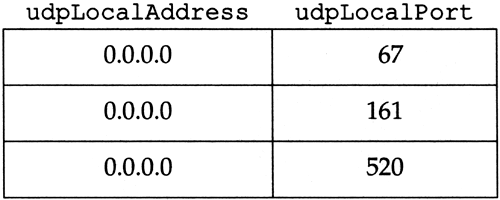25.6 Instance Identification
25.6 Instance Identification
Every variable in the MIB must be identified when SNMP is referencing it, to fetch or set its value. First, only leaf nodes are referenced. SNMP does not manipulate entire rows or columns of tables. Returning to Figure 25.7, the leaf nodes are the four that we described in Figure 25.8 and the two in Figure 25.9. mib, udp, udpTable, and udpEntry are not leaf nodes.
Simple Variables
Simple variables are referenced by appending ".0" to the variable's object identifier. For example, the counter udpInDatagrams from Figure 25.8, whose object identifier is 1.3.6.1.2.1.7.1, is referenced as 1.3.6.1.2.1.7.1.0. The textual name of this reference is iso.org.dod.internet.mgmt.mib.udp.udpInDatagrams.0.
Although references to this variable are normally abbreviated as just udpInDatagrams.0, we reiterate that the name of the variable that appears in the SNMP message (Figure 25.2) is the object identifier 1.3.6.1.2.1.7.1.0.
Tables
Instance identification of table entries is more detailed. Let's return to the UDP listener table (Figure 25.7).
One or more indexes are specified in the MIB for each table. For the UDP listener table, the MIB defines the index as the combination of the two variables udpLocalAddress, which is an IP address, and udpLocalPort, which is an integer. (We showed this index in the top row in Figure 25.9.)
Assume there are three rows in the UDP listener table: the first row is for IP address 0.0.0.0 and port 67, the second for 0.0.0.0 and port 161, and the third for 0.0.0.0 and port 520. Figure 25.11 shows this table.
Figure 25.11. Sample UDP listener table.

This implies that the system is willing to receive UDP datagrams on any interface for ports 67 (BOOTP server), 161 (SNMP), and 520 (RIP). The three rows in the table are referenced as shown in Figure 25.12.
Figure 25.12. Instance identification for rows in UDP listener table.

Lexicographic Ordering
There is an implied ordering in the MIB based on the order of the object identifiers. All the entries in MIB tables are lexicographically ordered by their object identifiers. This means the six variables in Figure 25.12 are ordered in the MIB as shown in Figure 25.13. Two key points result from this lexicographic ordering.
Figure 25.13. Lexicographic ordering of UDP listener table.

-
Since all instances for a given variable ( udpLocalAddress ) appear before all instances for the next variable in the table ( udpLocalPort ), this implies that tables are accessed in a column “row order. This results from the lexicographic ordering of the object identifiers, not the human-readable names .
-
The ordering of the rows in a table depends on the values of the indexes for the table. In Figure 25.13, 67 is lexicographically less than 161, which is lexicographically less than 520.
Figure 25.14 shows this column “row order for our sample UDP listener table.
Figure 25.14. UDP listener table, showing column “row ordering.

We'll also see this column “row ordering when we use the get “next operator in the next section.
EAN: 2147483647
Pages: 378